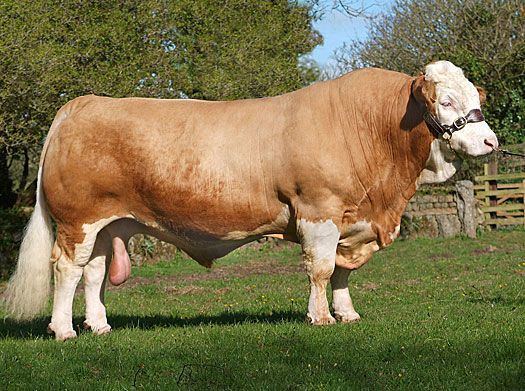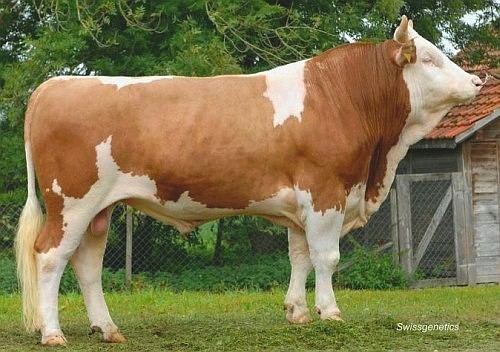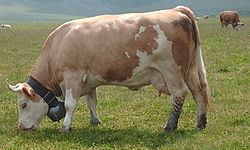Scientific name Bos taurus | Rank Breed | |
 | ||
Similar | ||
Cattle breeds e11 simmental cattle dual purpose type from austria simmentaler fleckvieh k he
Simmental cattle are a versatile breed of cattle originating in the valley of the Simme River, in the Bernese Oberland of western Switzerland.
Contents
- Cattle breeds e11 simmental cattle dual purpose type from austria simmentaler fleckvieh k he
- European origin
- North America
- Africa
- Soviet Union
- Different names
- Traditional
- Types
- United States
- References

European origin

Among the older and most widely distributed of all breeds of cattle in the world, and recorded since the Middle Ages, the Simmental breed has contributed to the creation of several other famous European breeds, including the Montbeliarde (France), the Razzeta d'Oropa (Italy), and the Fleckvieh (Germany).
North America

Reports from a variety of sources indicate Simmental cattle arrived in the United States before the turn of the 20th century. Simmentals were reported as early as 1887 in Illinois, according to one source; in 1895 in New Jersey; and in both New York and New Mexico around the 1916 to 1920 period. An advertisement in an 1896 issue of the Breeder's Gazette, published in Chicago, also made reference to "Simmental" cattle. However, those early imports did not capture the attention of American cattlemen and the Simmental influence died quietly away until the late 1960s.

The breed made its most recent appearance in North America when a Canadian, Travers Smith, imported the famed bull "Parisien" from France in 1967. Semen was introduced into the United States that same year, with the first half-blood Simmental calf born in February 1968. The American Simmental Association was formed in October 1968.

The American Simmental Association registers about 80,000 cattle annually into the Simmental and Simbrah herdbooks. The association ranks among the top four of the US beef breed associations in annual registrations.
Africa

Namibia (1893) and South Africa (1905) were the first countries outside Europe where the breed was successfully established. Here the breed is known as Simmentaler and is mainly used for beef cattle production under suckler cow systems. Today, the breeders' society is, as far as animal numbers are concerned, the fourth largest of the 32 nondairy breeds in Southern Africa. The main reasons for its popularity are (i) it can be used with great success in crossbreeding for breeding of both cows with much milk and heavy weaners/oxen, (ii) a large number of performance-tested bulls, (iii) comprehensive advice and other breed improvement services to its breeders, and (iv) animals that do not pass stringent inspection by breed experts, are permanently eliminated from the herdbook.
Soviet Union
In the former Soviet Union, the Simmental was the most important cattle breed. Russian Simmental (Симментальская корова) accounted for one-quarter of all cattle in the USSR. Through extensive crossbreeding, six strains were developed:
In 1990, there were 12,849,800 Simmental in the USSR. In 2003, the Simmental count in Russia stood at 2,970,400.
Different names
The breed is known under the following names
Pezzata Rossa: Italy. Montbéliarde: A French dairy breed. Member of European Simmental Federation but not of the World Simmental-Fleckvieh Federation.
Traditional
The Simmental has historically been used for dairy and beef, and as draught animals. They are particularly renowned for the rapid growth of their young, if given sufficient feed. Simmentals provide more combined weaning gain (growth) and milk yield than any other breed.
Africa
In contrast to countries which allow black and solid brown coloured Simmental in the herdbook, Namibia and South Africa only register Simmentaler with the typical colour i.e. from dark red or brown to yellow spread over the body in any pattern with at least some white on the forehead and the lower-leg area, solid black or solid red animals are non-existent because they are not registered.
Types
No other breed in the world has such a large within breed type-variation as Simmental-Fleckvieh which is classifiable in the following types:
The traditional colouration of the Simmental has been described variously as "red and white spotted" or "gold and white", although there is no specific standard colouration, and the dominant shade varies from a pale yellow-gold all the way to very dark red (the latter being particularly popular in the United States). The face is normally white, and this characteristic is usually passed to crossbred calves. The white face is genetically distinct from the white head of the Hereford.
United States
Today, about 80% of the Simmental cattle in the United States are black, with the remaining 20% being red. Most Simmental cattle are solid in coloring. From the late 60s to the 80s traditionally colored (spotted red and white) Simmental were deemed most desirable by Simmental breeders, as well as the industry. In the late 1980s and early 1990s, due to market premiums in the US, there was a strong push to produce Simmental that were black and solid in color pattern. Fortunately for the breed, given that these characteristics are controlled by single genes, the evolution was relatively rapid and straightforward. The bulk of the change was brought about through the use of purebred Simmental sires that carried genes for black and solid color. These sires were the result of a portion of Simmental breeders selecting for these genes in the "breeding up" process during the 70's and 80's. Today, Simmental cattle in North America are commonly homozygous for black and solid color genes, as well as being homozygous for the polled gene.
